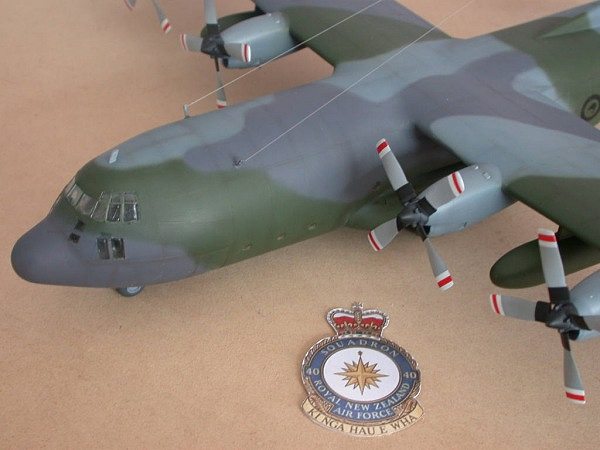
Flying Kiwis 1/72 C-130 Hercules
|
KIT # |
KC 90 |
|
PRICE: |
$69 NZ |
|
DECALS: |
Two 40 Sq RNZAF aircraft |
|
REVIEWER: |
Mark Fordham |
|
NOTES: |
RNZAF C-130 photo courtesy Scott Van Aken |

|
HISTORY |
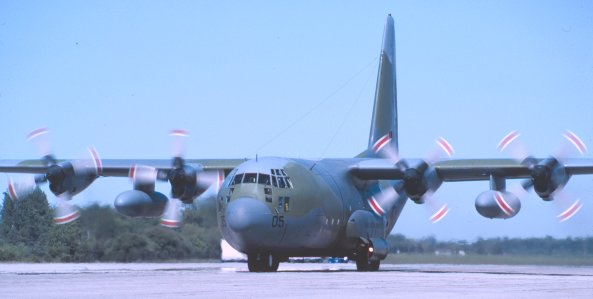
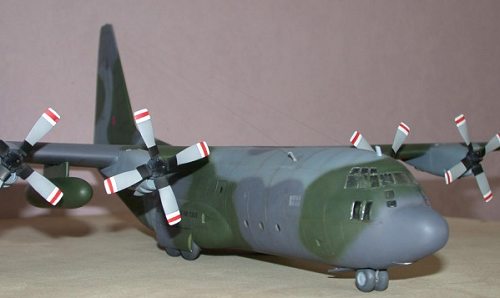 Five C-130H Hercules are
operated by No 40 squadron at the RNZAF Base Auckland Whenuapai. Three aircraft
entered service in 1965 with two more added in 1969. The Hercules operates the
RNZAF's long range strategic and tactical transport role and caters for routine
domestic ops as well as providing annual Antarctic support, national and
international emergency civil relief aid, refugee evacuation, areomedical
evacuations and search and rescue. As a tactical workhorse the Hercules is used
for carrying troops, casualty evacuations and can airdrop anything from simple
supplies to a bulldozer.
Five C-130H Hercules are
operated by No 40 squadron at the RNZAF Base Auckland Whenuapai. Three aircraft
entered service in 1965 with two more added in 1969. The Hercules operates the
RNZAF's long range strategic and tactical transport role and caters for routine
domestic ops as well as providing annual Antarctic support, national and
international emergency civil relief aid, refugee evacuation, areomedical
evacuations and search and rescue. As a tactical workhorse the Hercules is used
for carrying troops, casualty evacuations and can airdrop anything from simple
supplies to a bulldozer.
Between 1990 and 1991 a 40 Sqn detachment consisting of two C-130's operated out of Riyadh Saudi Arabia In medical support of Allied Forces during the Gulf war. The Venerable "Herky Bird" which celebrates its 37th anniversary of service with the RNZAF this year will continue to serve New Zealand for a few more years yet as the C-130 is not due for retirement until at least 2005 *see new information at bottom of page*.
|
THE KIT |
Like all Flying Kiwis kits to date the C-130 consists of a repackaged Italeri C-130 with a locally printed color plate and the new all black low viz decals currently being adopted by our C-130 fleet, these decals are printed in Italy and are very sharp and thin.
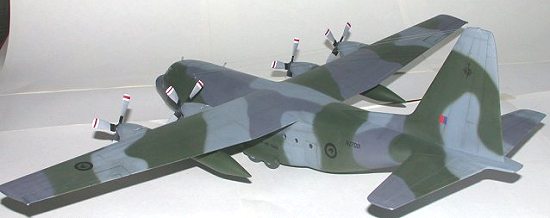 Flying Kiwis have left
the original Italeri instruction sheet in their kit and this could lead to a
little bit of confusion for the younger modeler or someone not familiar with
Kiwi Hercules as there is a number of parts supplied in the Kit that are not
needed for the RNZAF version.
Flying Kiwis have left
the original Italeri instruction sheet in their kit and this could lead to a
little bit of confusion for the younger modeler or someone not familiar with
Kiwi Hercules as there is a number of parts supplied in the Kit that are not
needed for the RNZAF version.
A number of blade aerials and the in-flight refueling probe can be consigned to the parts bin and unfortunately Flying Kiwi's do not include any extra notes on the placement of the Kiwi blades and suitable photos of the Kiwi C-130 will need to be found, one very good resource for this is the web site owned by Phillip Treweek http://www.kiwiaircraftimages.com who has just about all New Zealand aircraft walk-arounds available.
The Kiwi C-130's are currently being repainted with a new "Low-Viz" three tone camouflage scheme that's a cross between the old Vietnam USAF scheme and the current Euro-one camouflages comprising of light grey, dark grey and olive green in a free hand soft edge pattern over the entire airframe that makes the C-130 almost invisible at low levels against the greens and grays of our native bush.
|
CONSTRUCTION |
Think sub assemblies, that's the only way to tackle this beast by breaking it down into smaller manageable pieces I could at least fit the thing on my modeling desk up until the final assembly stage at least.
Starting with the wings as the first sub assembly the two piece wings were first taped together and MEK run along the joints and put to one side. The engine nacelles can be assembled at this time with one each comprising on only two pieces some extra work is needed to stop a see-thru look in the turbo-prop intakes, small pieces of 5 tho plastic card were cut to shape and added to each to blank them off.
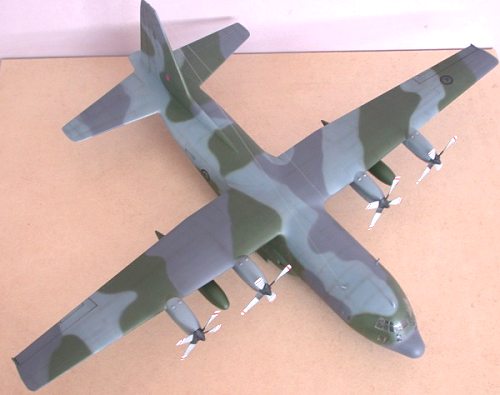 With the wings drying it
was time to do the cockpit, the Italeri cockpit contains enough detail to
satisfy most people in this scale so the cockpit was painted dark gray and
dry-brushed with light gray, almost nothing of the cockpit can be seen once the
fuselage has been closed up so no more time was wasted detailing something that
will never be seen.
With the wings drying it
was time to do the cockpit, the Italeri cockpit contains enough detail to
satisfy most people in this scale so the cockpit was painted dark gray and
dry-brushed with light gray, almost nothing of the cockpit can be seen once the
fuselage has been closed up so no more time was wasted detailing something that
will never be seen.
The Italeri C-130 comes with some interior detailing consisting of a floor, forward bulkhead and ramp detail unfortunately not really enough to display the rear ramp down without adding some extra detailing on the sides at least.
Once it was finished due to it's size would be packed away in the "Too big to display box" I opted (copped out?) to leave the interior out and close up the rear ramps, the floor and bulkhead won't go to waste as a friend of mine is going to modify them to fit the Airfix C-130 he has.
With the interior finished the fuselage halves were glued using good old Revell tube glue for strength as the last thing you want to do is to pop a seam on this sucker. Fit wasn't the best with a fair amount of filler needed on the upper forward fuselage to blend the two together, take the time to get all the sink-marks as well paying particular attention to sink marks around the alignment pins.
The C-130 may be a big plane in 1/72nd scale but it's a simple model and went together very quickly with most of the time spent on filling and sanding the fuselage. Trying to blend in the canopy to fuselage took a fair amount of time and sanding with a noticeable step still left in the joint. I didnít put the small glass windows in at this point as I use Kristal Klear to do the small windows after the model is complete.
Undercarriage was fitted at this point that while simple produced a very strong unit to support the rather big and heavy aircraft, remember there is a fair amount of lead in the nose of this beast to get it to sit on it's nose wheel.
|
CAMO & MARKINGS |
 With the wings added
using tube glue and the unsightly gaps filled, polished and rescribed the Herky
Bird was almost ready for the paint shop. Flying Kiwi's recommend and quote
Tamiya paints for the tri-color wrap around Low Viz camo that the RNZAF C-130
have sported for the East Timor Operations.
With the wings added
using tube glue and the unsightly gaps filled, polished and rescribed the Herky
Bird was almost ready for the paint shop. Flying Kiwi's recommend and quote
Tamiya paints for the tri-color wrap around Low Viz camo that the RNZAF C-130
have sported for the East Timor Operations.
Tamiya XF-66 Light grey was first sprayed to act as a primer and first camo color. Two bottles were needed to get good coverage and cover up the scratches. Once the Light Gray had dried for a week the Olive Green XF-58 was free hand sprayed using the supplied painting guide. The Dark Gray was then added to complete the main painting. Lots of touchups were needed to eliminate overspray on all three of the colors. All in all the touch-ups took longer than the original paint job.
Painting the C-130 took a sum total of 10 hours and consumed 6 bottles of paint! I initially didnít like the patchy look that to constant touch ups created but on close inspection of the photos of our C-130ís and being able to get up close and personal with one at our local airfield they look like they where painted with spray bombs and birds**t and did indeed have a patchy and dirty look about them.
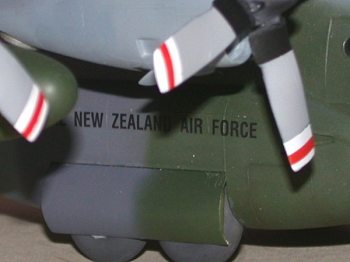 The propellers took
forever to mask off and spray due to their multi colors, but they do add a bit
of color to the Herky-bird.
The propellers took
forever to mask off and spray due to their multi colors, but they do add a bit
of color to the Herky-bird.
Future Floor polish was then added to where the decals were to go and left to dry for a couple of days. Like all Flying Kiwi decals they went on with no problems but I have noticed with some of my earlier Flying Kiwi decals that I did not seal with a gloss coat after drying are now starting to crack and flake in the heat. Sealing the decals with a couple of coats of future and then finishing off with the final matt coat seems to stop this problem.
Final post shading and grime was added using chalk pastels and once I was happy with the amount of dirt the C-130 was given a couple of medium coats of Humbrol Matt Kote to seal in everything.
This is one big plane! Most
people are only ever going to build one of them in
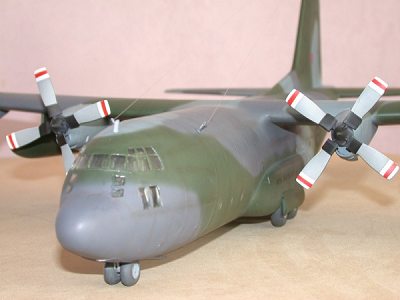 this or 1/48th
scale due to storage limitations. So if you are going to have one of these
beasts hanging around why not do one of the lesser known users of the C-130. For
those overseas readers who fancy doing one of the RNZAF C-130 but do not want to
spent the money on shipping the beast, Flying Kiwiís also sell the Decals sheets
separately and can be ordered through most models shops in New Zealand. You can
email me off board if you require more information on getting these sheets
(subject to availability).
this or 1/48th
scale due to storage limitations. So if you are going to have one of these
beasts hanging around why not do one of the lesser known users of the C-130. For
those overseas readers who fancy doing one of the RNZAF C-130 but do not want to
spent the money on shipping the beast, Flying Kiwiís also sell the Decals sheets
separately and can be ordered through most models shops in New Zealand. You can
email me off board if you require more information on getting these sheets
(subject to availability).
As a Side note the New Zealand Government has just announced (11/2002) that they are to spend $660 Million on upgrading our Transport fleet over the next few years ďA structural upgrade of the C130H Hercules transports will extend their life by 15 years for between $100 million and $170 million. The aircrafts' communications and navigation systems will also be upgraded.Ē So It looks like the C-130 is going to be around for a long time yet in our skies, hopefully giving the Kiwi modeler a few new paint schemes to choose from rather than the dirty Low-Viz ones.
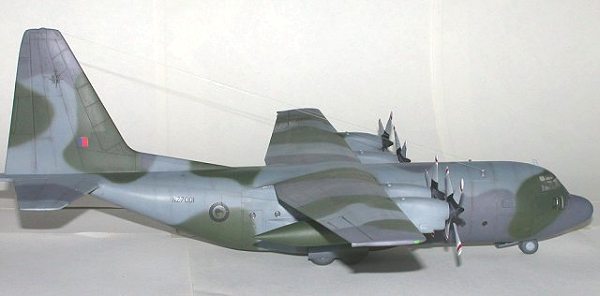
|
REFERENCES |
Mk 1 Eyeball as the C-130ís regularly re-fuel at my local airfield.
http://www.kiwiaircraftimages.com
http://www.airforce.mil.nz
New Zealand Aircraft Illustrated Handbookew kit
December 2002
Copyright ModelingMadness.com
If you would like your product reviewed fairly and quickly, please contact the editor or see other details in the Note to Contributors.
Back to the Reviews Index Page